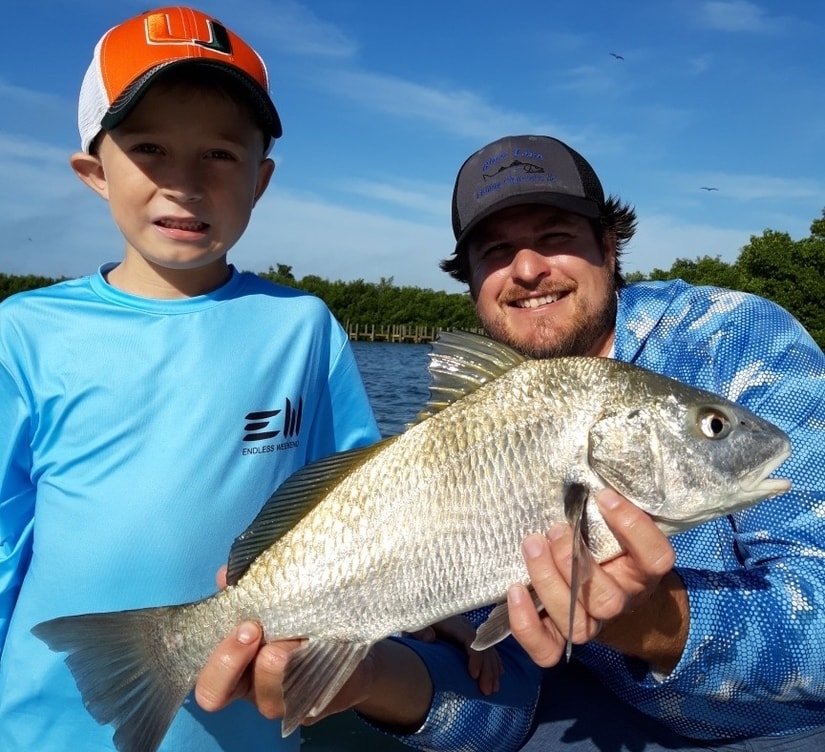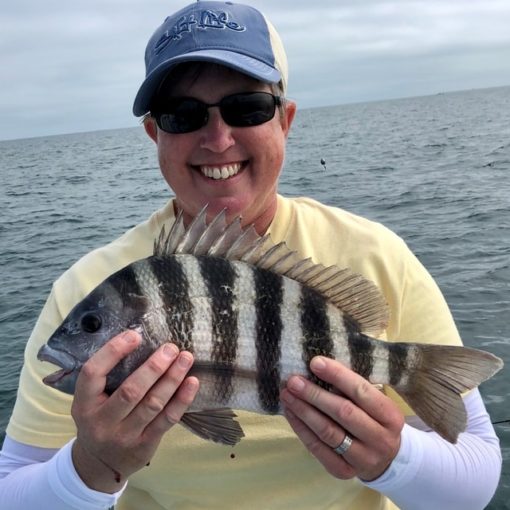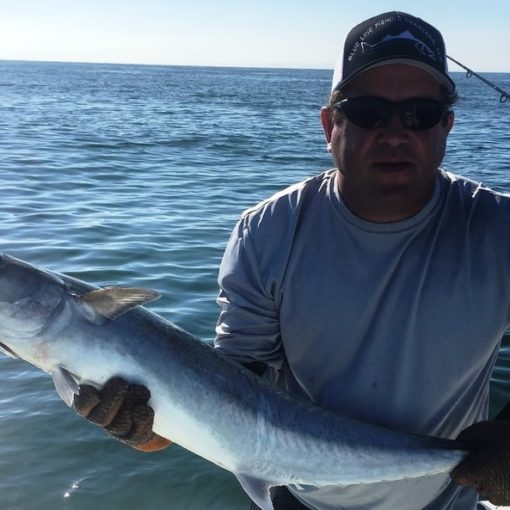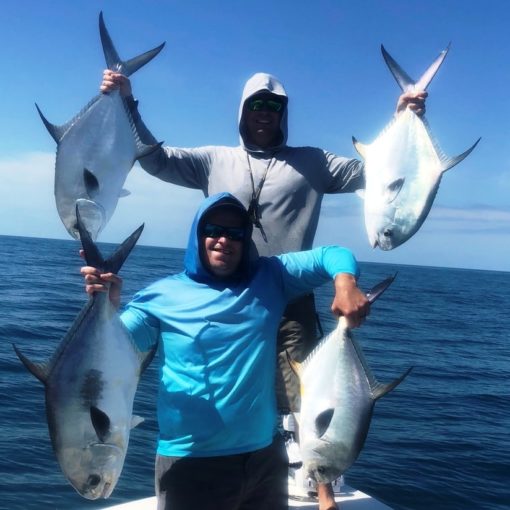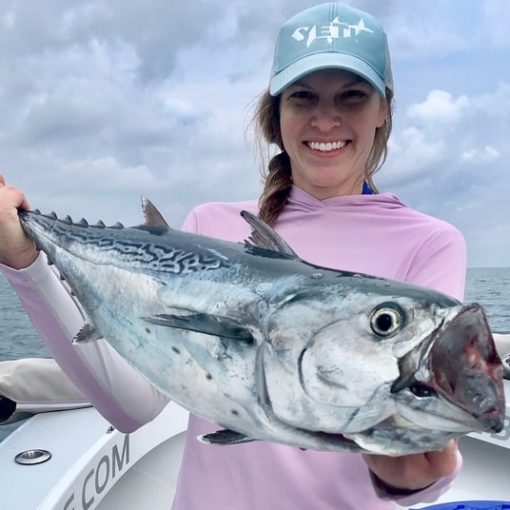The black drum is the largest member of the drum family. It is also noted for its longevity – some reports suggest they live for up to 60 years in certain habitats. In the Gulf however the oldest individuals found to date have been under 45. Gulf black drum also don’t grow as big as their relatives on the Atlantic coastline. There are reports of Atlantic drum weighing a whopping 130 pounds but the heaviest yet found in the Gulf has been 50 pounds. Nevertheless, black drum are big heavy fish regardless of habitat!
The species’ scientific name is Pogonias cromis. Other common names are drum, drummer, drumfish, and tambour. It is related to the red drum (Sciaenops ocellatus). Captive breeding programs have interbred red and black drum to produce a large and very vigorous but sterile hybrid. Some reports suggest this interbreeding also happens in the wild but it’s unlikely. Whilst the two types of drums do often live in close proximity, they spawn at different times.
The fish in this family get the name ‘drum’ courtesy of a drumming sound males make during spawning by vibrating muscles in their swim bladder.
Identifying Black Drum
Juvenile black drum have conspicuously different coloration to adults. Their silvery grey body has 4 or 5 broad dark vertical stripes down each side. In this respect, and also in body shape, they are similar to sheepshead and can be mistaken for one. However black drum, even juveniles, have a clump of sensitive whiskers or barbels under their chin. Sheepshead don’t.
Sheepshead also have an awe inspiring set of humanoid looking teeth at the front of their mouths. Black drum do have teeth but they’re pharyngeal teeth located in the back of their throat. Both species are specialists though when it comes to shell crushing. It’s a handy ability to have when your favorite food lives in hard shells!
The juvenile stripes fade as the fish matures and the grey darkens to a dark speckled color. The belly is white or light grey, particularly in older adults. However, their dark coloring varies in intensity depending on habitat. For instance, adults that live in clearer Gulf waters tend to be lighter than those found in murky or muddy water.
They have a roughly rectangular shaped body with a short head and a steep slope up to the first dorsal fin. The mouth is large and blunt and acts as a suction cup for sucking in prey.
Finding Black Drum
They are are found along Atlantic coast of the US and in the Gulf of Mexico. They’re most prolific in the Gulf, notably off the coast of Texas. However, there are significant populations on the Atlantic coast south of Chesapeake Bay.
Their preferred habitat is close to their favorite food, which happens to be oysters! They also like clams so anywhere with a soft or sandy seafloor close to these food sources is where you’ll most likely find them. During warmer weather, this will be mostly inshore in shallow brackish water. Over winter you’ll need to look further offshore because they will typically move to deeper water when it gets cold. They are susceptible to extreme and sudden water temperature drops. If caught in one, it can decimate their numbers.
Spawning – There’s Safety In Numbers
Spawning season for black drum begins around January when large numbers of adults begin to gather for ‘the Drum Run’. They collect in shallow water close to oyster beds, and throughout January and February feed extensively on the oysters. These schools are not seen at other times of the year. There can be hundreds of black drum in the schools. For keen black drum anglers, this is the best time to catch them. Contact us to arrange your black drum fishing in Cape Coral.
Black drum will spawn in river systems, estuaries, bays, or out in the Gulf waters. These locations also change from season to season depending on conditions. This behavior may seem like indiscriminate spawning but it’s actually highly specific. They spawn when the water is the right temperature. They also spawn when and where there are optimal levels of dissolved oxygen in the water. This seems to be between certain hours of an evening, with peaks during the new and full moon.
Females spawn between 20 and 30 times a season and can release up to 60 million eggs during that time. Once the eggs are fertilized, they drift in the sea currents until hatching. Black drum eggs hatch within 24 hours of spawning. The larvae then ride the incoming currents back to shore and into coastal tidal marshes to grow.
Sensing Food
Whilst in the larval stage, black drum eat zooplankton. As young juveniles their diet expands to include small fish, crustaceans and worms. Adults like crabs, small fish, shrimp and of course oysters.
Black drum are bottom feeders. When searching for food, they swim with their heads down so the barbels under their chin can feel out prey. When something edible is detected, the fish stops and sucks it into its large mouth before slowly moving forward again. The motion pushes the prey to the back of their throat where those highly efficient cobblestone shaped teeth crush it.
Because they can eat hard-shelled prey most other fish can’t get at, black drum don’t face much competition for food. However, their voracious appetite for oysters potentially puts them in direct conflict with oyster farmers. Studies with captive drum indicate they can eat up to 40 oysters a day. A drum run through an oyster farm would do significant damage.
Black drum themselves are a prey species for larger fish like sharks. They’re also a popular sporting and recreational fish for humans!
Fishing For Black Drum
Florida has bag and size limits for black drum. To ensure you don’t inadvertently break the rules, it’s best to book a charter with a company that knows them well. Blue Line Fishing Charters has been operating Cape Coral Florida fishing charters for many years. Contact us to book your bull drum fishing trip today.

